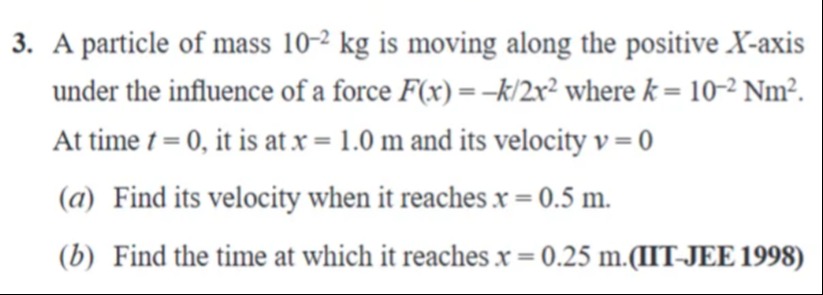Question
Question: A particle of mass $10^{-2}$ kg is moving along the positive X-axis under the influence of a force $...
A particle of mass 10−2 kg is moving along the positive X-axis under the influence of a force F(x)=−k/2x2 where k=10−2Nm2. At time t=0, it is at x=1.0 m and its velocity v=0
(a) Find its velocity when it reaches x=0.5 m.
(b) Find the time at which it reaches x=0.25 m.(IIT-JEE 1998)

(a) -1 m/s, (b) π/3+3/4 s
Solution
Solution: The problem describes a particle of mass m=10−2 kg moving along the positive X-axis under the influence of a force F(x)=−k/(2x2), where k=10−2Nm2. At t=0, the particle is at x0=1.0 m with velocity v0=0.
Part (a): Find its velocity when it reaches x=0.5 m. The force is conservative, so we can use the work-energy theorem or conservation of mechanical energy. The work done by the force F(x) as the particle moves from x1 to x2 is W=∫x1x2F(x)dx. According to the work-energy theorem, W=ΔKE=KEf−KEi. The initial state is at x0=1.0 m with v0=0. The initial kinetic energy is KEi=(1/2)mv02=0. The final state is at xf=0.5 m with velocity vf. The final kinetic energy is KEf=(1/2)mvf2. The work done is W=∫1.00.52x2−kdx=−2k∫1.00.5x−2dx=−2k[−x−1]1.00.5=−2k[−0.51−(−1.01)]=−2k[−2+1]=−2k[−1]=2k. Using the work-energy theorem: W=KEf−KEi. 2k=21mvf2−0. vf2=mk. Given k=10−2Nm2 and m=10−2 kg, vf2=10−210−2=1. So, vf=±1 m/s. The force F(x)=−k/(2x2) is always negative for x>0, meaning it acts towards the origin. Since the particle starts at x=1.0 m and moves towards x=0.5 m, its position is decreasing, which means its velocity must be negative. Thus, the velocity when it reaches x=0.5 m is vf=−1 m/s.
Part (b): Find the time at which it reaches x=0.25 m. We need to find the velocity as a function of position first. Using conservation of mechanical energy is convenient. The potential energy U(x) is given by F(x)=−dU/dx. U(x)=−∫F(x)dx=−∫2x2−kdx=2k∫x−2dx=2k(−x1)+C=−2xk+C. Let's set the potential energy to zero at infinity, so C=0. U(x)=−k/(2x). The total mechanical energy E=KE+PE=21mv2+U(x). The initial energy at t=0, x0=1.0 m, v0=0: E0=21m(0)2+U(1.0)=0−2(1.0)k=−2k. By conservation of energy, the total energy E is constant and equal to E0. 21mv2+U(x)=−2k. 21mv2−2xk=−2k. 21mv2=2xk−2k=2k(x1−1). v2=mk(x1−1). Since the particle is moving towards the origin from x=1.0, the velocity is negative: v=dtdx=−mk(x1−1). We need to find the time taken to go from x0=1.0 m to xf=0.25 m. dt=vdx=−mk(x1−1)dx=−kmx1−xdx=−km1−xxdx. Integrate from t=0 to t and from x=1.0 to x=0.25: ∫0tdt=∫1.00.25−km1−xxdx. t=−km∫1.00.251−xxdx. Substitute m=10−2 and k=10−2, so m/k=1=1. t=−∫1.00.251−xxdx. Let's evaluate the integral ∫1−xxdx. Substitute x=sin2θ. Then dx=2sinθcosθdθ. x=sinθ and 1−x=1−sin2θ=cosθ (for x∈[0,1)). ∫cosθsinθ(2sinθcosθ)dθ=∫2sin2θdθ=∫(1−cos2θ)dθ=θ−21sin2θ+C=θ−sinθcosθ+C. Substitute back x=sin2θ, so θ=arcsin(x). The integral is arcsin(x)−x1−x+C. Now evaluate the definite integral from x=1.0 to x=0.25. When x=1.0, x=1, arcsin(1)=π/2. x1−x=1×0=0. Value is π/2. When x=0.25, x=0.5, arcsin(0.5)=π/6. x1−x=0.5×1−0.25=0.5×0.75=0.5×3/2=3/4. Value is π/6−3/4. The definite integral ∫1.00.251−xxdx=[arcsin(x)−x1−x]1.00.25 =(arcsin(0.25)−0.251−0.25)−(arcsin(1.0)−1.01−1.0) =(arcsin(0.5)−0.5×0.75)−(arcsin(1)−1×0) =(π/6−0.5×3/2)−(π/2−0) =π/6−3/4−π/2=(π−3π)/6−3/4=−2π/6−3/4=−π/3−3/4. The time t=−×(−π/3−3/4)=π/3+3/4.
The final answer is π/3+3/4 seconds.
Explanation of the solution: (a) Use the work-energy theorem ∫xixfF(x)dx=21mvf2−21mvi2. Calculate the integral of the force from x=1.0 m to x=0.5 m. Set vi=0 at xi=1.0 m and solve for vf at xf=0.5 m. Determine the sign of the velocity based on the direction of motion. (b) Use the definition of velocity v=dx/dt. From energy conservation, find the expression for v(x). Separate variables to get dt=dx/v(x). Integrate dt from t=0 to t and dx from x=1.0 m to x=0.25 m. Evaluate the definite integral using an appropriate substitution (like x=sin2θ).
